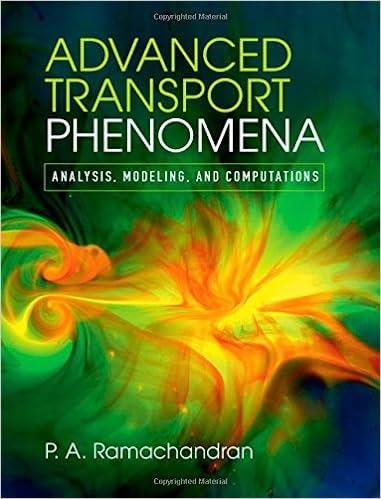Consider the system of IVP in the matrix form which is repeated here for convenience: [frac{d boldsymbol{y}}{d
Question:
Consider the system of IVP in the matrix form which is repeated here for convenience:
\[\frac{d \boldsymbol{y}}{d t}=\tilde{A} \boldsymbol{y}+\boldsymbol{R}\]
Eigenvalue representation is a useful and important concept in linear algebra. This exercise walks you through the key step in solving the IVP by the eigenvalue method. First one has to evaluate the eigenvalues of the matrix \(\tilde{A}\) and the eigenvectors for each of these eigenvalues. The MATLAB command eig (A) can be used for this purpose. The statement to use is
\[[\mathrm{V}, \mathrm{L}]=\operatorname{eig}(\mathrm{A})\]
Show that the solution of the IVPs for \(R=0\) can then be represented in a compact vectormatrix notation as
\[\boldsymbol{y}=\tilde{V} \operatorname{diag}(\lambda t) \boldsymbol{\alpha}\]
where \(\alpha\) is a vector of integration constants. This vector can be estimated by applying the initial conditions. If \(\boldsymbol{y}_{0}\) is the vector of initial conditions then
\[\boldsymbol{\alpha}=\boldsymbol{V}^{-1} \boldsymbol{y}_{0}\]
Hence the solution can also be expressed as
\[\boldsymbol{y}=\tilde{V} \operatorname{diag}(\lambda t) \boldsymbol{V}^{-1} \boldsymbol{y}_{0}\]
Simple MATLAB multiplication commands can be used to do the numerics:
\[\mathrm{y}=\mathrm{V} * \operatorname{diag}(\exp (\operatorname{diag}(\mathrm{L} * \text { time }))) * \operatorname{inv}(\mathrm{V}) * \mathrm{y} 0\]
Implement this in MATLAB, and test it on some sample problems in compartmental modeling.
Note that the exponential of a matrix is related to the modal matrix by \[\exp (\tilde{A} t)=\tilde{V} \operatorname{diag}(\lambda t) \boldsymbol{V}^{-1}\]
and hence the two representations are equivalent. Verify this in MATLAB.
Step by Step Answer:

Advanced Transport Phenomena Analysis Modeling And Computations
ISBN: 9780521762618
1st Edition
Authors: P. A. Ramachandran





